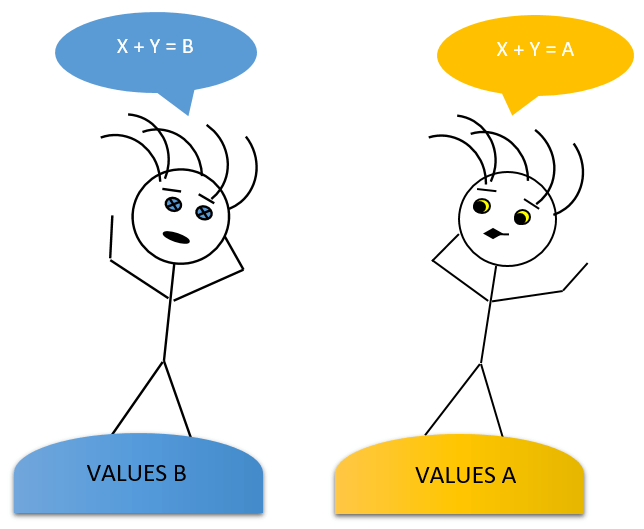You’ve seen it happen again and again. You are debating with your team on how to solve a big, hairy problem. After much deliberation, you see one solution as best. Another leader sees a different solution as ideal. And here you thought you two were all synced up on your goals.
What the heck do you do in these situations?
Often, we push past these dilemmas with the biggest-title-in-the-room-chooses method.
Which works. But it can leave us about as satisfied as a carnivorous body builder after a piquant vegan snack. Which, if you don’t follow my bizarre simile, equates to not-satisfied-at-all.
Is that you? Don’t you wonder why two bright, smart, strategic leaders come to wildly different conclusions about what to do in one situation? How can you tell who is right? Is it just a matter of one being misinformed, or can both be right? Can both be wrong?
Maybe each leader is solving for different values.
Whoa. What are we talking about math for? Solving for values, huh?
Think about it, dear reader. Leader A might be prioritizing efficient and repeatable operations in his inner calculations about what the best solution will be. Leader B might be prioritizing a culture of continuous and rapid innovation in her implicit mathematics. Despite these differences, both value customer experience and business growth, so they agree on a lot.
Yet, despite what they agree on, their different values-prioritizations will generate wildly different solutions to whatever problem besets them. So yes. Their math is different. They are solving for different values.
Solving for values. Core values.
We read a lot about the beatific and magical effect that ‘strong core values’ has on your business’ success. It’s worth doing, because identifying your business’ top values tells everyone what you’re solving for.
Consider the opening conflict as a conflict of values.
Imagine if both leaders had explicitly agreed on what values are most important to the business’ success and shouldn’t be compromised. Before the dilemma ever hit their horizon of concern— they agree on what matters most. In so doing, they have pre-defined what values should be prioritized when solving business dilemmas.
Pre-defined values prioritization allows the argument over alternatives to feel less personal and less weighted on who stands to gain most from whatever option. Which is personal. It’s better to be less personal in these situations. So assume all discernable facts and variables are on the table. Imagine having the dilemma debate it’s not about opinions, power and authority. It’s not about who is “right.” It’s about which solution solves for the values that matter most. And that’s a more productive way to go.
Which brings us to values.
There are lot of good things in the world. Things that are valuable. Valued. We call them values. We value some things more than others. With family, we are programmed to value some things most and other things least. When we’re at work, we may prioritize values differently. If we change jobs, that prioritization of values can change.
How business dilemmas show us our values.
We often confront dilemmas in business. Let’s call them business dilemmas. Business dilemmas don’t have a clear right or wrong answer based solely on the known facts of the situation. You have a business dilemma when you try to decide what the right way to go is and the clear answer is “it depends”. Business dilemmas are open to interpretation. No right answer. That’s a business dilemma.
Use dilemmas to figure out if your values-in-action match your values-on-the-wall.
If we need to understand and agree upon our values to help our teams solve the business dilemmas we face in our work, then how can we figure out what those values are? It’s often a matter of going off-site with a facilitator with sticky notes, flip charts, and white board scrawlings. Which isn’t terrible. It’s a good start.
Let’s flip it around. What if there was a way to get your team to answer a bunch of business dilemmas and give you a data-rich map of what values the leaders on your team are prioritizing in their choices?
Why business dilemmas demonstrate your team’s values-in-action.
This works. Because values expression has everything to do with how a group of people systematically resolve dilemmas. Using a tool like Novarete, you can have your team respond to business dilemmas and get a snapshot of the values the team prioritizes when making tough decisions. Then you can see if your values on the wall match your values in action.


